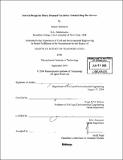Service design for heavy demand corridors : limited-stop bus service
Author(s)
Schwarcz, Stacey
DownloadFull printable version (7.325Mb)
Other Contributors
Massachusetts Institute of Technology. Dept. of Civil and Environmental Engineering.
Advisor
Nigel H.M. Wilson and John Attanucci.
Terms of use
Metadata
Show full item recordAbstract
Many transit agencies run both limited-stop and local service along some of their heavy ridership corridors. The primary benefit of limited-stop bus service is higher speed which results in reduced running time and thus reduced travel time for passengers. This reduced travel time can improve the service quality for existing passengers and can increase ridership on the route and thus both passengers and the agency can benefit from limited- stop service. However, this strategy also results in increased access time, and in increased wait time for some passengers. This thesis develops a model to evaluate limited stop bus service and then applies the model to develop general design guidelines for limited-stop service. The model created evaluates a specific service configuration including both the local and limited-stop headways and stops. The model calculates travel times, and assigns existing demand to limited and local stops and to limited and local routes, based on minimum passenger (weighted) travel time. This assignment is applied at the origin-destination pair level. The model then calculates several measures of effectiveness, which are used to compare different configurations, including market share (local preferred, limited preferred, and choice passengers), stop and route assignment (number of passengers selecting the limited service stops and limited-stop service), net change in passenger travel time (weighted and un-weighted), and finally productivity (passengers per trip and per vehicle hour for the local and limited-stop service). The model was used to analyze two CTA cases: Western Avenue local Route 49 and limited-stop Route X49, and the Madison Avenue Route 20. (cont.) The analysis of Western Avenue and Madison Avenue involved testing alternative frequency configurations; alternate stop spacing configurations were analyzed only for Madison Avenue. The specific findings on these routes show that the existing stop spacing on Route X49 is effective, but to improve the overall effectiveness of the route the limited-stop frequency share should be increased to at least 60% of all service on the corridor. Limited-stop service on Madison Avenue was found not to be effective under any configuration due to short trip lengths and evenly distributed demand along the route. The results of the analysis were used to develop two sets of guidelines: corridor (or route) potential for limited stop service and limited-stop service design. The corridor potential guidelines suggest that high concentrations of origins and destinations and long passenger trips are both critical to the effectiveness of limited-stop service. Additional factors that affect the corridor potential for limited-stop service are the existing headway and ridership and the potential for route level running time savings. Limited-stop service design guidelines were developed for setting stop spacing and frequency share. The stop spacing on the limited-stop service should be decided by placing stops at the highest demand points and at all transfer points, and is guided by the distribution of origins and destinations, with the goal of attaining a wide enough stop spacing to achieve significant route level travel time savings. One of the major findings of this thesis is that limited-stop service is generally most effective at greater than 50% frequency share.
Description
Thesis (S.M.)--Massachusetts Institute of Technology, Dept. of Civil and Environmental Engineering, 2004. Includes bibliographical references (leaves 109-110).
Date issued
2004Department
Massachusetts Institute of Technology. Department of Civil and Environmental EngineeringPublisher
Massachusetts Institute of Technology
Keywords
Civil and Environmental Engineering.